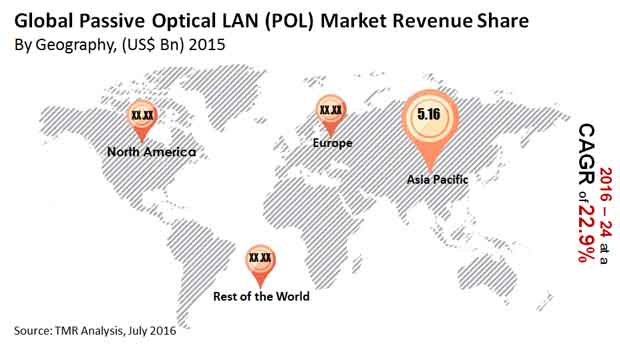
The market for passive optical LAN (POL) is led by Huawei Technologies Co., Ltd., ZTE Corporation, and Alcatel-Lucent S.A. These three companies accounted for a combined share of over 75% in the overall POL market in 2015, indicating the high degree of consolidation. Transparency Market Research finds that most of these companies are focusing on business expansion to increase their consumer base and new product development and technological enhancement to deliver value enhancements to customers.
An increasing number of companies in the passive optical LAN market are also focusing on innovative and technological advancements and R&D efforts in passive optical networks (PON). Acquisitions are another way of expanding customer base and reducing competition.
Some of the other key companies in the POL market are Ericsson Inc., Adtran Inc, Freescale Semiconductor Inc., Motorola Solutions Inc., Mitsubishi Electric Corporation, and Verizon Communications Inc. Staying on the crest of the technology wave is becoming a success imperative, as can be seen with developments such as the rolling out of Huawei’s 4G ultra broadband networks. The company endeavors to gain an advantage in markets such as Rio de Janeiro (Brazil), Bangalore (India), and Stockholm (Sweden) with the move.

Accelerating Bandwidth Requirements Driving Need for Passive Optical LAN
“The growing need for higher bandwidth is a major opportunity for players in the passive optical LAN market,” states the lead analyst. IT professionals have declared that the demand for higher bandwidth is presently large and is likely to grow in the near future owing to the increasing number of subscribers using a greater number of connected devices and data-dense services. “Africa and Asia are likely to witness a sudden surge in the demand for bandwidth, rising at a CAGR of more than 38%,” the analyst predicts.
Request Sample For More Information@
https://www.transparencymarketresearch.com/sample/sample.php?flag=S&rep_id=2945
Moreover, POL solutions are greener than conventional copper-based Ethernet local area networks. This is expected to further bolster the passive optical LAN market over the forecast period. TMR predicts that the impact of this factor will remain high over the coming years.
Geographically, the market is dominated by Asia Pacific and is expected to continue doing the same in the coming years on account of the rising demand for passive optical network in the emerging nations such as China. The increasing demand for more bandwidth and the fact that passive optical LAN systems are energy efficient and long lasting, have further propelled its demand in the developing nations of Asia Pacific such as India, and others. The development of systems administration advances in the Asia Pacific and markets in the other parts of the world, expanding fiber organizations, and rising interests in innovative headways and exploration framework across both the locales are additionally pushing the passive optical LAN market.
On the other side, North America stands in close competition to Asia Pacific and generate notable revenues on account of the rising demand for advanced security and for energy preservation. There is also an increased demand for simplified network operations will also add fuel to the growth of the passive optical LAN market in the coming years.
Request For Custom Research Report@
https://www.transparencymarketresearch.com/sample/sample.php?flag=CR&rep_id=2945
POL arrangements are environment-friendly than regular copper-based Ethernet neighborhood. This is relied upon to additional support the passive optical LAN market over the figure time frame. The rising adoption of energy-efficient products is likely to create lucrative growth opportunities for the market in the coming years.





